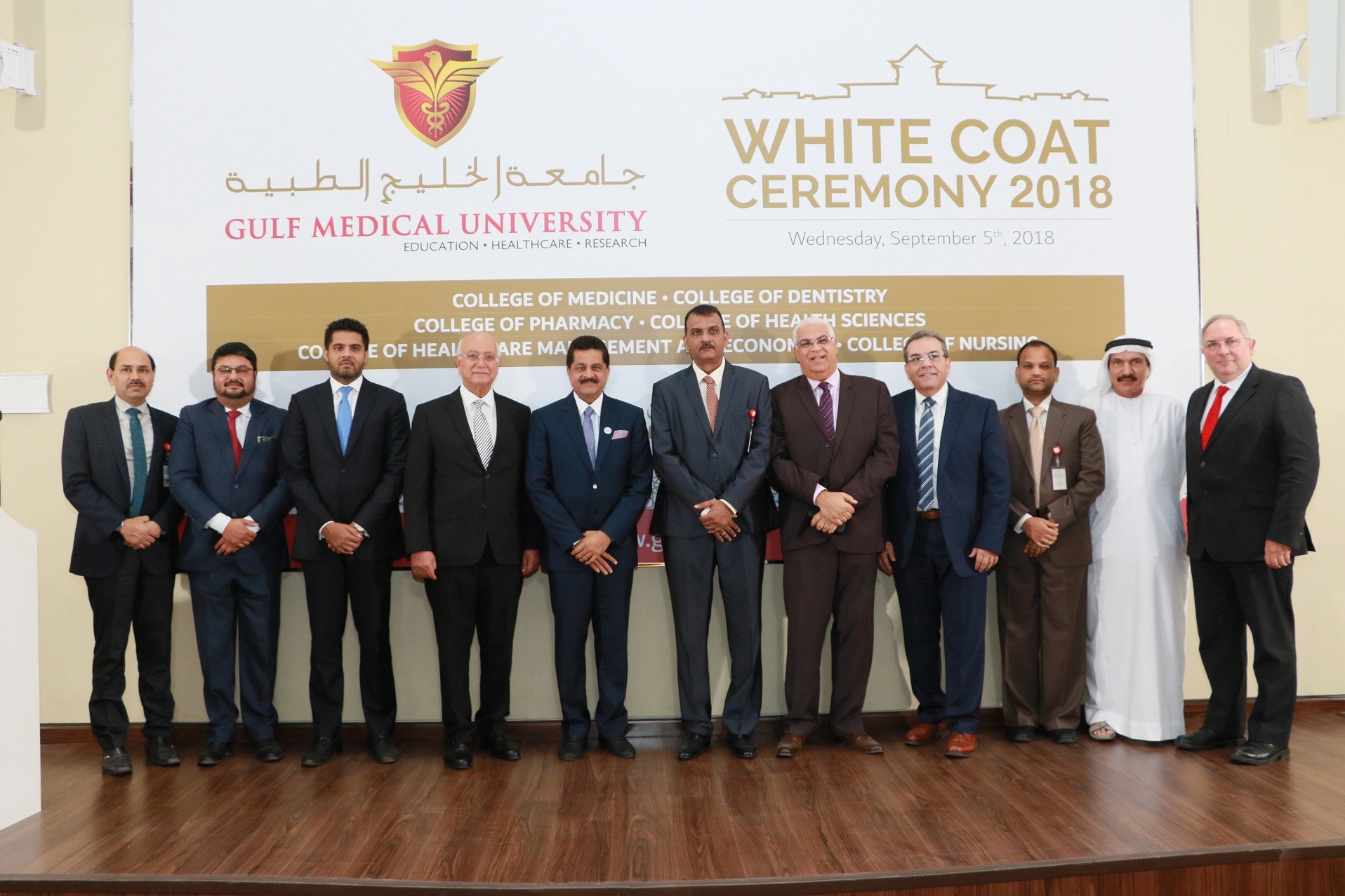Ajman, UAE : More than 400 students of Gulf Medical University, the prominent private medical university of the Gulf region, completed their white coats – the mantle of the health profession, and took their Medical Students’ Oath as they were formally inducted into their respective medical courses at the White Coat Ceremony held at the University campus on 5th September 2018.
The ceremony was held for the new students of Medicine, Biomedical Sciences, and Associate Degree in Pre-Clinical Sciences, Physiotherapy, Dentistry, Pharmacy, Medical Laboratory Sciences, Medical Imaging Sciences, and Anesthesia Technology.
Addressing the gathering, Prof. Hossam Hamdy, Chancellor of GMU, said “Professionalism, Care & Empathy and Trustworthiness are the three core principles of the medical career. How to communicate, connect, interact and feel will play a key role in educating health professionals.”
Dr. Thumbay Moideen, founder, President Board of Trustees, Gulf Medical University was the chief guest of the White Coat Ceremony. Prof. Hossam Hamdy, presided over the function. The ceremony marked the first step in the healthcare careers of the new students who are now part of GMU’s 80+ nationalities-strong student community.
Speaking at the occasion, Dr. Thumbay Moideen thanked His Highness Sheikh Humaid bin Rashid Al Nuami, UAE Supreme Council Member and Ruler of Ajman, for his continuous support for Gulf Medical University, which has become an academic beacon and home for pioneering research and innovation, and the place where UAE doctors and medical professionals are qualified to provide the best healthcare.
Prof. Hossam Hamdy formally welcomed the new class of students. Stressing the importance of human communication and interaction in the medical profession, he said, “Medical sciences will always rely on communication between human beings. The patient, the student, the healthcare provider, and the medical educator are all humans. How to communicate, connect and interact and feel will play a key role in educating Health professional.
“We will train you on how to be a better communicator.” He reminded the new students that Professionalism, Care & Empathy and Trustworthiness are the three core principles of their chosen career. He added that Gulf Medical University is internationally leading in education technology development,” he added.
This year, (GMU) launched two new colleges; the Nursing College and College of Healthcare Management and Health Economics, which brings the total number of colleges to six. The University offers 23 accredited courses, with additional courses awaiting accreditation, expected to be added soon. GMU has an active collaboration with a number of prestigious universities around the world as well as world-renowned research institutes.
The Gulf Medical University Academic Health System (GMUAHS), the only private Academic Health System in the region, links the healthcare, medical education, and research functions on its own. Research is an essential strategic direction of GMUAHS. The Thumbay Research Institute for Precision Medicine leads research in the field of cancer biology and immunology, with international collaboration with France, Poland and Korea.
The strategic plans of Gulf Medical University include increasing its global footprint by setting up three new medical university campuses in three different countries and transforming into a research-based university by 2025.
Let the Truth be known. If you read VB and like VB, please be a VB Supporter and Help us deliver the Truth to one and all.
Visakhapatnam (PTI): India fought back gallantly through Prasidh Krishna and Kuldeep Yadav after Quinton de Kock struck his 23rd hundred, keeping South Africa to a manageable 270 in the third and series-deciding final ODI, here Saturday.
India won the toss after judging the spin of the coin incorrectly 20 times in a row. They had little hesitation in inserting the Proteas into bat, a clear indication of dew factor dominating the thought.
After Arshdeep Singh sent back Ryan Rickelton early, De Kock (106, 89b, 8x4, 6x4) struck his seventh century against India and put on 113 runs off 124 balls with skipper Temba Bavuma (48, 67b) as the visitors moved to a healthy position.
De Kock was severe on Prasidh (4/66), who erred on length continuously in his first spell (2-0-27-0). The left-hander biffed the pacer for 6, 6, 4 in his second over to milk 18 runs.
The 32-year-old quickly pounced on anything that was short, and pacers Prasidh and Harshit offered him plenty of feed on his pet areas.
Bavuma was more sedate, and made runs through those typical dabs and jabs, occasionally unfurling a drive of elan.
De Kock moved to fifty in 42 balls, and never let the tempo down reaching his hundred in 79 balls.
India found temporary relief when Ravindra Jadeja induced a false slash from Bavuma to get caught by Virat Kohli at point.
The tourists got another move on through a 54-run partnership between De Kock and Matthew Breetzkle for the third wicket, and at 168 for two in 28 overs they were in a good position to press on.
But Breetzke's punishment of part-time spinner Tilak Varma forced a rethink in the Indian camp, as skipper KL Rahul brought back Prasidh for a second spell.
What a masterstroke it turned out to be! The Karnataka man broke the back of South Africa’s top and middle order in an exceptional second spell (4-0-11-3).
Breetzke was the first man to go, trapped plumb in front with a straight one and four balls later Aiden Markram uppishly chipped a fuller delivery to Kohli at short covers.
Prasidh soon castled De Kock, whose ugly cross-batted swipe failed to connect a full length delivery from the pacer.
All of a sudden, SA found themselves at a shaky 199 for five, losing three wickets in the space of three overs.
Once Prasidh was done away with the top and middle-order, left-arm wrist spinner Kuldeep (4/41) took over and mopped up the tail as SA fell short of even a par total on this track.






